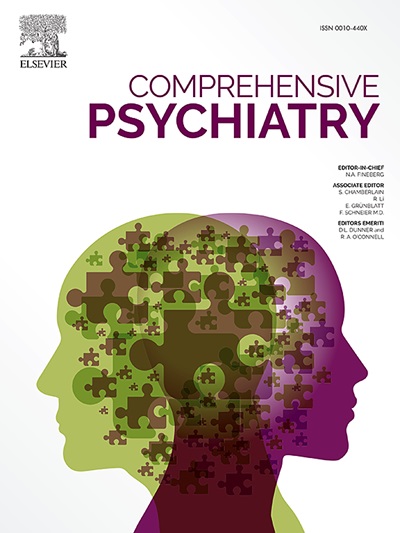Schizophrenia genetic risk and labour market outcomes in the Finnish general population: Are schizophrenia-related traits penalised or rewarded?
IF 4.2
2区 医学
Q1 PSYCHIATRY
引用次数: 0
Abstract
Background
Schizophrenia polygenic risk scores (SCZPRS) have been linked to cognitive functioning, creativity, behavioural traits, and psychiatric conditions beyond schizophrenia. This study examines how labour market segments reward or penalise traits associated with SCZPRS in the general population.
Methods
We merged genetic, socio-economic and health registry data with repeated cross-sectional survey data from six Finnish cohorts (1992 to 2017), representing individuals aged 25–64 across Finnish regions (N = 20,121). Various regression models were employed to study labour market outcomes.
Results
Individuals in the highest SCZPRS quintile were 6.4 percentage points less likely to be employed than those in the lowest quintile (P < 0.001; 99.5 % CI: 3.9–9.0 pp). Among employed individuals in knowledge-based occupations, an inverse U-shaped relationship between SCZPRS and income emerged after 2000. Knowledge workers in both the lowest (P = 0.004) and highest (P = 0.03) SCZPRS quintiles were 4–5 percentage points less likely to be in the highest income tertile than those in the middle quintile. No significant association was found between SCZPRS and income in physical labour.
Conclusions
Beyond its overall negative association with employment, SCZPRS exhibits a non-linear relationship with income in cognitive-intensive occupations, where both low and high SCZPRS appear to be penalised. This pattern became more pronounced post-2000, coinciding with rising income inequality and technological advancements, likely reshaping labour market demands. While effect sizes are substantial, compensatory factors may mitigate these outcomes. Greater awareness of these associations and individual differences in labour market experiences could contribute to a more inclusive society.
芬兰普通人群的精神分裂症遗传风险和劳动力市场结果:精神分裂症相关特征是惩罚还是奖励?
精神分裂症多基因风险评分(SCZPRS)与认知功能、创造力、行为特征和精神分裂症以外的精神疾病有关。本研究考察了劳动力市场如何奖励或惩罚一般人群中与SCZPRS相关的特征。方法:我们将遗传、社会经济和健康登记数据与来自6个芬兰队列(1992年至2017年)的重复横断面调查数据合并,代表了芬兰地区25-64岁的个体(N = 20121)。采用各种回归模型来研究劳动力市场的结果。结果SCZPRS最高五分之一的个体就业率比最低五分之一的个体就业率低6.4个百分点(P <;0.001;99.5% CI: 3.9-9.0 pp)。在知识型职业的就业者中,2000年后SCZPRS与收入呈负u型关系。SCZPRS最低(P = 0.004)和最高(P = 0.03)五分之一的知识工作者进入最高收入五分之一的可能性比中等收入五分之一的知识工作者低4-5个百分点。SCZPRS与体力劳动收入之间无显著关联。除了与就业总体负相关外,在认知密集型职业中,SCZPRS与收入表现出非线性关系,在这些职业中,SCZPRS低和高似乎都受到惩罚。这种模式在2000年后变得更加明显,与此同时,收入不平等加剧,技术进步,可能会重塑劳动力市场需求。虽然效应大小很大,但补偿性因素可能会减轻这些结果。更多地认识到这些联系和劳动力市场经验中的个体差异可以有助于建立一个更具包容性的社会。
本文章由计算机程序翻译,如有差异,请以英文原文为准。
求助全文
约1分钟内获得全文
求助全文
来源期刊

Comprehensive psychiatry
医学-精神病学
CiteScore
12.50
自引率
1.40%
发文量
64
审稿时长
29 days
期刊介绍:
"Comprehensive Psychiatry" is an open access, peer-reviewed journal dedicated to the field of psychiatry and mental health. Its primary mission is to share the latest advancements in knowledge to enhance patient care and deepen the understanding of mental illnesses. The journal is supported by a diverse team of international editors and peer reviewers, ensuring the publication of high-quality research with a strong focus on clinical relevance and the implications for psychopathology.
"Comprehensive Psychiatry" encourages authors to present their research in an accessible manner, facilitating engagement with clinicians, policymakers, and the broader public. By embracing an open access policy, the journal aims to maximize the global impact of its content, making it readily available to a wide audience and fostering scientific collaboration and public awareness beyond the traditional academic community. This approach is designed to promote a more inclusive and informed dialogue on mental health, contributing to the overall progress in the field.
 求助内容:
求助内容: 应助结果提醒方式:
应助结果提醒方式:


